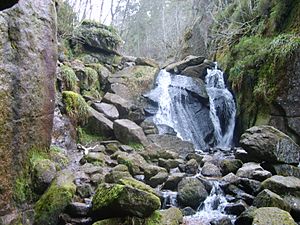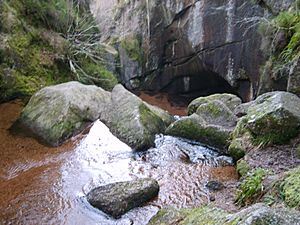Burn O'Vat facts for kids
Burn O'Vat is a really cool natural spot in Aberdeenshire, Scotland. It's near Loch Kinord and the village of Dinnet. It's basically a giant, bowl-shaped hole in the rock, also known as a pothole, carved out by water over thousands of years.
Contents
How Burn O'Vat Was Formed
Around 16,000 years ago, a huge sheet of ice, called a glacial ice sheet, covered this area. About 14,000 years ago, the weather got warmer. This caused the giant ice sheet to melt.
Lots of water, called meltwater, rushed down. This water carried rocks and boulders that were stuck in the ice. These rocks were super important for making Burn O'Vat.
Imagine a rock getting stuck in a small dip on the river bed. The fast-moving meltwater flowed around this rock in a swirling motion. Over a very long time, this swirling water and the rocks it carried slowly wore away the ground underneath. This process created the deep, round hole we now call a pothole.
About 13,500 years ago, the amount of meltwater decreased. The stream started to deposit (drop off) sand and gravel more than it was eroding (wearing away). This means the bottom of the pothole filled up with sediment. Scientists think this sand and gravel goes down about 5 to 7 meters below the ground you see today!
The pothole, which locals call 'The Vat', is quite big. It measures 18 meters across and is 13 meters high from the ground level. About 12,000 years ago, the entrance to the Vat was opened up. The same stream that formed the Vat, now flowing as a waterfall, wore away the rock in front of it.
The Vat Burn Stream
The Vat Burn is the stream that created Burn O'Vat. It still flows through the Vat today. This stream starts about 1.2 kilometers east of the Vat, on Culblean Hill. It flows east, right through the Vat, and then into Loch Kinord. The Vat Burn is about 2.2 kilometers long and usually about 2.7 meters wide.
History and Legends of The Vat
Local stories say that the cave behind the waterfall in the Vat was a hiding spot for Rob Roy. He was a famous outlaw. But actually, this isn't true! The cave was used by another outlaw named Patrick Gilroy Macgregor. He was known for his adventures in Deeside in the 1600s. He might have even been related to Rob Roy.
Visiting Burn O'Vat Today
Today, Burn O'Vat is a very popular place for tourists to visit. There are many walking paths around the area, and you can even walk right into the Vat itself!
Burn O'Vat also has a visitor center. Here, you can see taxidermy models (stuffed animals that look real) of local wildlife. The center also has detailed information about how the local land, or topography, was formed. Both the visitor center and the Vat itself are highly rated, earning four stars from the Scottish Tourist Board.






